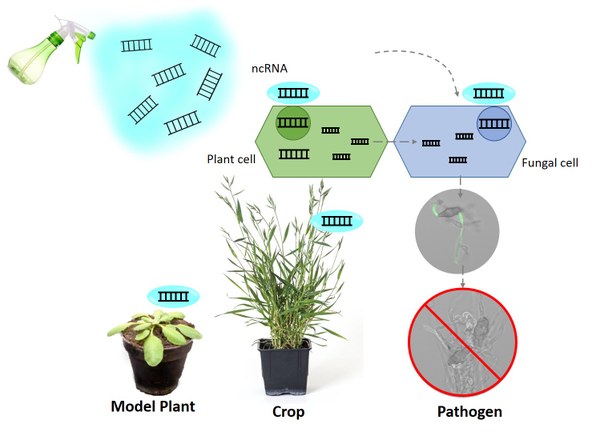Non-coding RNA application and uptake mechanisms
Maria Ladera-Carmona
Background: RNA interference (RNAi) is a natural mechanism conserved across (almost all) eukaryotes. Since its discovery, RNAi has become a powerful tool to modulate gene expression and to control pathogens through topical application of non-coding (nc)RNA molecules (i.e. double-stranded [ds]RNA, small regulatory [s]RNA, circular [circ]RNA). ncRNA are natural molecules with a sequence-specific mode of action and thus represent environmentally friendly alternatives to chemical pesticides. By specific ncRNA-mediated silencing of essential and/or infection-associated genes, we can control pathogens in a highly specific way. In this respect, spray-induced gene silencing (SIGS) has attracted much attention as more flexible, field applicable alternative to transgenic host-induced gene silencing (HIGS) approaches. It thus opens new control strategies in that plants, similar to human health therapies, can be treated with ncRNA-based vaccines for pathogen protection.
Project: While ncRNA spraying has an enormous bio-control potential, application procedures and their validation are required before any implementation in the field. Parameters to consider include defining the correct target gene, the specificity of the ncRNA sequence to avoid off-target effects on non-intended species (such as beneficial microorganisms) or the efficiency on the ncRNA to effectively stop fungal growth or infection. Moreover, ncRNA spraying specially demands for evaluating the mode of ncRNA application. In our lab, all these aspects are being investigated to validate ncRNA-based strategies for the control of plant pathogens. This includes in silico studies, followed by in vitro experiments and finally in planta treatments at the lab and field scale.
Lab tools / techniques: in vitro dsRNA production, gene expression analysis, RNA-detection by confocal microscopy, infection assays, spray-induced gene silencing.

